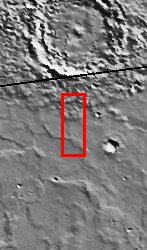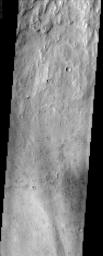Hesperia Planum
Caption:

(Released 16 May 2002)
The Science
This THEMIS visible image shows a close-up view of the ridged plains in Hesperia Planum. This region is the classic locality for martian surfaces that formed in the "middle ages" of martian history. The absolute age of these surfaces is not well known. However, using the abundance of impact craters, it is possible to determine that the Hesperian plains are younger than the ancient cratered terrains that dominate the southern hemisphere, and are older than low-lying plains of the northern hemisphere. In this image it is possible to see that this surface has a large number of 1-3 km diameter craters, indicating that this region is indeed very old and has subjected to a long period of bombardment. A large (80 km diameter) crater occurs just to the north (above) this image. The material that was thrown out onto the surface when the crater was formed ("crater ejecta") can be seen at the top of the THEMIS image. This ejecta material has been heavily eroded and modified since its formation, but there are hints of lobate flow features within the ejecta. Lobate ejecta deposits are thought to indicate that ice was present beneath the surface when the crater was formed, leading to these unusual lobate features. Many of the Hesperian plains are characterized by ridged surfaces. These ridges can be easily seen in the MOLA context image, and several can be seen cutting across the lower portion of the THEMIS image. These "wrinkle" ridges are thought to be the result of compression (squeezing) of the lavas that form these plains.
The Story
The rough-and-tumble terrain at the top of this image is made of material that was thrown out onto the surface when the massive, almost 50-mile-wide crater in the context image (see right) was blasted out of the surface. This ejected material shows longtime signs of erosion, but what's intriguing to geologists are residual signs of a curved, rounded flow pattern. Seeming to drip down the surface like a very thick, layered candle wax, the appearance of these lobes might mean that ice was present beneath the surface when the crater was formed. If dry dirt and rock alone had been ejected, we probably wouldn't see these flow-like features.
Note how tiny craters polka-dot the surface below this ejecta blanket. Most of them have very ragged, eroded edges. This terrain is clearly very old, and has been subjected to a whole lot of bombardment in its time. How old is it? Well, to understand, you need to know a little about the way planets form and evolve.
After a new star is formed, there's a lot of leftover dust and gas around it. Eventually, all of this material runs into each other and clumps together due to gravitational attraction. Eventually, these clumps of material grow so large that they become young planets. In a young solar system, there are many pieces of "stuff" still orbiting out there in space, and when they run into a rocky planet, they blast away at the surface, forming craters. Eventually, these leftover orbiting bodies have mostly all impacted. It's a good thing we're in an age where there's relatively little material left to run into our planet, though of course it still happens sometimes.
By looking at this surface in the Hesperian plains of Mars, we can see that it's old, but maybe not so ancient as the heavily cratered terrain dominating the southern hemisphere of Mars. . . and yet not so young as the low-lying plains in the northern hemisphere, which were smoothed over at some point late enough in Martian history to be almost crater-free thereafter. That puts the terrain in this image in the so-called "middle ages" of Martian history. By comparing all of the differently aged surfaces they can observe, geologists can piece together a record of Mars' geologic history.
Geologists can also make another comparison to understand how planets commonly form and evolve. You can see some ridges that cut across the bottom of the image (seen more clearly in the context image to the right). These "wrinkle" ridges are probably created when the lava that formed these plains was squeezed and compressed. Wrinkle ridges are found not only on Mars, but also on the moon, so that tells us it is not a unique process occurring in only one place in the solar system.
Cataloging Keywords:
| Name |
Value |
Additional Values |
| Target |
Mars |
|
| System |
|
|
| Target Type |
Planet |
|
| Mission |
2001 Mars Odyssey |
|
| Instrument Host |
Mars Odyssey |
|
| Host Type |
Orbiter |
|
| Instrument |
Thermal Emission Imaging System (THEMIS) |
|
| Detector |
|
|
| Extra Keywords |
Crater, Dust, Grayscale, Impact, Rotation |
| Acquisition Date |
|
| Release Date |
2002-06-04 |
| Date in Caption |
2002-05-16 |
|
| Image Credit |
NASA/JPL/Arizona State University |
| Source |
photojournal.jpl.nasa.gov/catalog/PIA03797 |
| Identifier |
PIA03797 |


